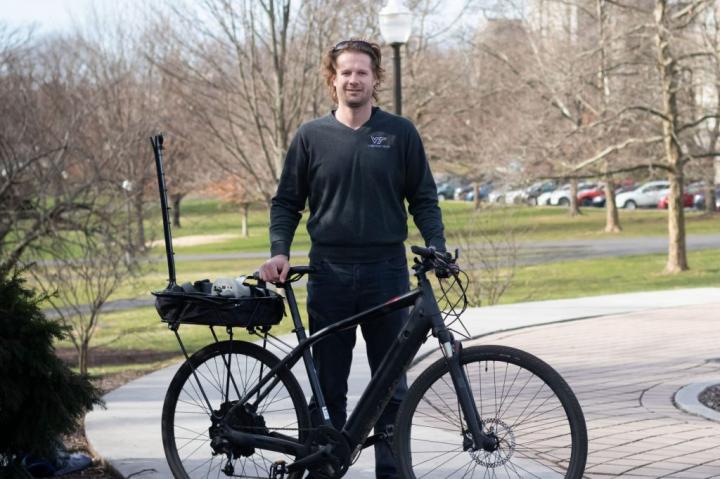
Credit: Emily Roediger for Virginia Tech
When you walk or bike around your city or neighborhood, how do you choose your route? Does pollution factor into that decision? If it doesn’t, it probably should.
Steve Hankey not only wants to measure pollution around cities’ roadways and walkways. He also wants to educate citizens about those measurements so they have an opportunity to change their active transportation habits for the better.
Hankey, an assistant professor in the School of Public and International Affairs (SPIA) within the College of Architecture and Urban Studies, is the first faculty member from SPIA to receive a Faculty Early Career Development (CAREER) Program award from the National Science Foundation (NSF). Thanks to the $500,000 award, Hankey’s five-year project will measure pollution using various sensors and engage the public by tracking their pollution intake using a smartphone app.
The app will estimate the pollution along users’ paths but also show them alternate routes to take where the air is cleaner. Hankey will collect data for the research by mining Google Street View Imagery and measuring air pollution with 50 stationary PurpleAir low-cost sensors along with two mobile high-cost sensors that will be attached to bicycles.
“The point of going out and measuring air pollution using bicycles is to visit a large variety of locations and see where the clean and dirty areas might be,” explained Hankey. “We’re also going to attach low-cost sensors to the bicycles to assess the difference in data quality between high- and low-cost sensors and determine if the additional expense is justified.”
As part of the research, Hankey is also partnering with high school students from African-American fraternal organizations who will test a smartphone app that tracks an individual’s exposure to pollution when walking or bicycling around Washington, D.C. These students will collect data and work with graduate students in Virginia Tech’s urban and regional planning program to suggest improvements to roadways and street designs.
With these data points, the students can propose changes to urban planners for D.C’s roadways and walkways. The smartphone app, developed through a partnership with the Center for Geospatial Information Technology and the University of Minnesota, will be publicly available to all citizens.
“The big picture in developing our models and collecting these measurements is to help provide publicly available information so that people can better understand how to reduce their exposure,” Hankey said. “The project will also provide methods for exposure assessment that could help health effects studies be more successful.”
In addition to pollution from vehicles, many other factors are associated with air quality, like green space or impervious surfaces.
Another impact that Hankey hopes to shed light on with this project is to offer some alternative approaches for current urban design standards, like how roadways and city blocks are built and how those changes are executed. These approaches could cost less or be easier to implement than current methods. They could make a difference on peoples’ exposure – and ultimately their health – because of the alternative design.
This process will be greatly influenced by the outreach of students who are testing the app. Students will be able to use the app, see where the air quality is poor, and then come together and talk about their experiences. Further outreach with urban planners from Northern Virginia and Washington, D.C., could be even more influential for a long-term planning effort.
“There’s the long-range component of getting everybody involved in these processes, including the community, to try and advocate for changes,” said Hankey. “But there’s also the individual learning component of having the app and seeing what you’re exposed to and being able to change your own behavior – for example, when you’re biking to work and you see a highly polluted road and you think, ‘Oh, maybe I should take a slight detour.’ There’s the institutional piece and also the individual piece.”
Getting people moving in cleaner air is a professional – and personal – passion of Hankey’s, as evidenced by this project.
“It’d be great to design cities where people can be protected from environmental hazards, where they’d have the choice to be physically active, and include areas that promote good mood or mental states,” said Hankey. “That’s the overarching goal for my research.”
Hankey believes cities like these are the cities people should be building, and his NSF CAREER grant will provide further data to better implement those designs.
This project received initial funding from the Institute for Critical Technology and Applied Science and the Institute for Society, Culture, and Environment. Additional supporters and ongoing partner organizations include the Center for Geospatial Information Technology in the College of Natural Resources and Environment, the Center for Enhancement of Engineering Diversity in the College of Engineering, and the Institute for Policy and Governance.
###
Media Contact
Emily Roediger
[email protected]
540-231-2108
Original Source
https:/




